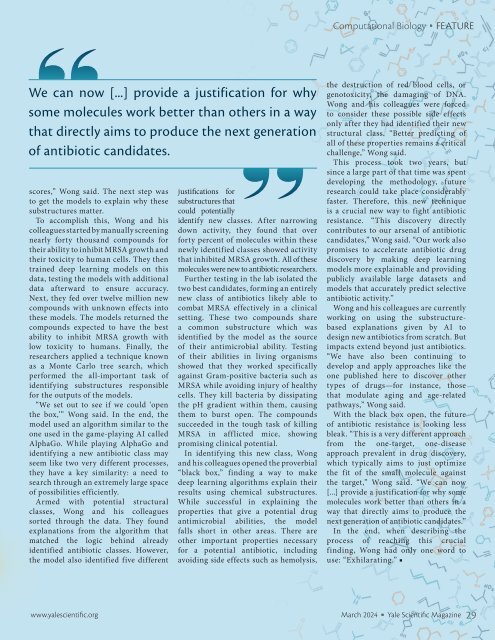YSM Issue 97.1
You also want an ePaper? Increase the reach of your titles
YUMPU automatically turns print PDFs into web optimized ePapers that Google loves.
Computational Biology<br />
FEATURE<br />
We can now [...] provide a justification for why<br />
some molecules work better than others in a way<br />
that directly aims to produce the next generation<br />
of antibiotic candidates.<br />
scores,” Wong said. The next step was<br />
to get the models to explain why these<br />
substructures matter.<br />
To accomplish this, Wong and his<br />
colleagues started by manually screening<br />
nearly forty thousand compounds for<br />
their ability to inhibit MRSA growth and<br />
their toxicity to human cells. They then<br />
trained deep learning models on this<br />
data, testing the models with additional<br />
data afterward to ensure accuracy.<br />
Next, they fed over twelve million new<br />
compounds with unknown effects into<br />
these models. The models returned the<br />
compounds expected to have the best<br />
ability to inhibit MRSA growth with<br />
low toxicity to humans. Finally, the<br />
researchers applied a technique known<br />
as a Monte Carlo tree search, which<br />
performed the all-important task of<br />
identifying substructures responsible<br />
for the outputs of the models.<br />
“We set out to see if we could ‘open<br />
the box,’” Wong said. In the end, the<br />
model used an algorithm similar to the<br />
one used in the game-playing AI called<br />
AlphaGo. While playing AlphaGo and<br />
identifying a new antibiotic class may<br />
seem like two very different processes,<br />
they have a key similarity: a need to<br />
search through an extremely large space<br />
of possibilities efficiently.<br />
Armed with potential structural<br />
classes, Wong and his colleagues<br />
sorted through the data. They found<br />
explanations from the algorithm that<br />
matched the logic behind already<br />
identified antibiotic classes. However,<br />
the model also identified five different<br />
justifications for<br />
substructures that<br />
could potentially<br />
identify new classes. After narrowing<br />
down activity, they found that over<br />
forty percent of molecules within these<br />
newly identified classes showed activity<br />
that inhibited MRSA growth. All of these<br />
molecules were new to antibiotic researchers.<br />
Further testing in the lab isolated the<br />
two best candidates, forming an entirely<br />
new class of antibiotics likely able to<br />
combat MRSA effectively in a clinical<br />
setting. These two compounds share<br />
a common substructure which was<br />
identified by the model as the source<br />
of their antimicrobial ability. Testing<br />
of their abilities in living organisms<br />
showed that they worked specifically<br />
against Gram-positive bacteria such as<br />
MRSA while avoiding injury of healthy<br />
cells. They kill bacteria by dissipating<br />
the pH gradient within them, causing<br />
them to burst open. The compounds<br />
succeeded in the tough task of killing<br />
MRSA in afflicted mice, showing<br />
promising clinical potential.<br />
In identifying this new class, Wong<br />
and his colleagues opened the proverbial<br />
“black box,” finding a way to make<br />
deep learning algorithms explain their<br />
results using chemical substructures.<br />
While successful in explaining the<br />
properties that give a potential drug<br />
antimicrobial abilities, the model<br />
falls short in other areas. There are<br />
other important properties necessary<br />
for a potential antibiotic, including<br />
avoiding side effects such as hemolysis,<br />
the destruction of red blood cells, or<br />
genotoxicity, the damaging of DNA.<br />
Wong and his colleagues were forced<br />
to consider these possible side effects<br />
only after they had identified their new<br />
structural class. “Better predicting of<br />
all of these properties remains a critical<br />
challenge,” Wong said.<br />
This process took two years, but<br />
since a large part of that time was spent<br />
developing the methodology, future<br />
research could take place considerably<br />
faster. Therefore, this new technique<br />
is a crucial new way to fight antibiotic<br />
resistance. “This discovery directly<br />
contributes to our arsenal of antibiotic<br />
candidates,” Wong said. “Our work also<br />
promises to accelerate antibiotic drug<br />
discovery by making deep learning<br />
models more explainable and providing<br />
publicly available large datasets and<br />
models that accurately predict selective<br />
antibiotic activity.”<br />
Wong and his colleagues are currently<br />
working on using the substructurebased<br />
explanations given by AI to<br />
design new antibiotics from scratch. But<br />
impacts extend beyond just antibiotics.<br />
“We have also been continuing to<br />
develop and apply approaches like the<br />
one published here to discover other<br />
types of drugs—for instance, those<br />
that modulate aging and age-related<br />
pathways,” Wong said.<br />
With the black box open, the future<br />
of antibiotic resistance is looking less<br />
bleak. “This is a very different approach<br />
from the one-target, one-disease<br />
approach prevalent in drug discovery,<br />
which typically aims to just optimize<br />
the fit of the small molecule against<br />
the target,” Wong said. “We can now<br />
[...] provide a justification for why some<br />
molecules work better than others in a<br />
way that directly aims to produce the<br />
next generation of antibiotic candidates.”<br />
In the end, when describing the<br />
process of reaching this crucial<br />
finding, Wong had only one word to<br />
use: “Exhilarating.” ■<br />
www.yalescientific.org<br />
March 2024 Yale Scientific Magazine 29

















